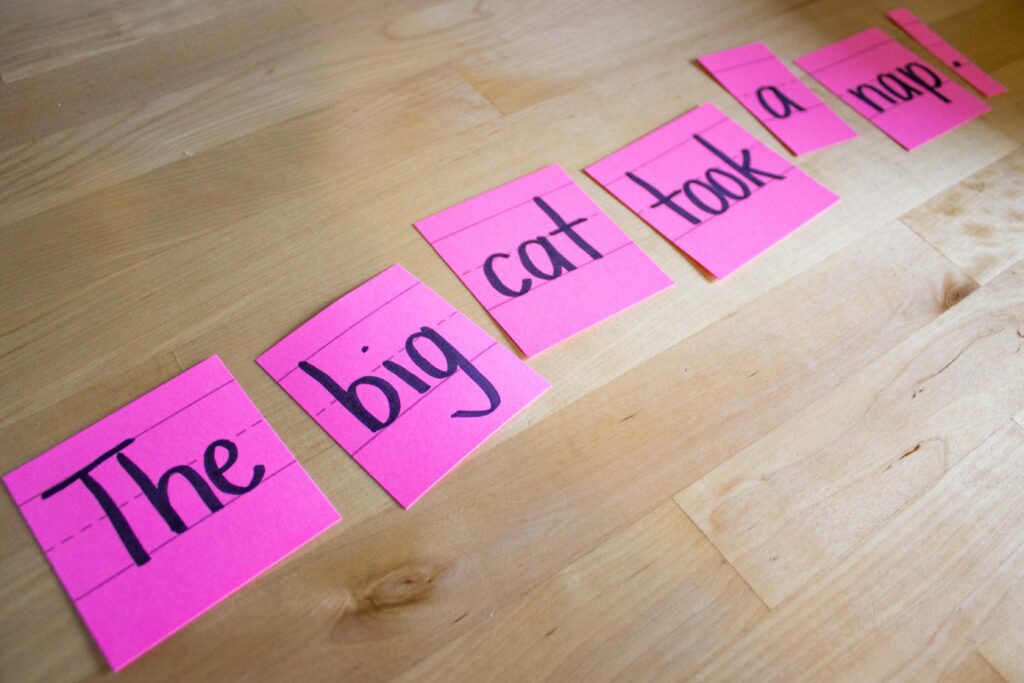How to Boost Reading Success by Building Print Awareness
Have you ever asked yourself what you can do with your pre-readers to help set them up for success on their reading journey?
If that sounds like you, I’ve got great news for you! There are actually a number of things that you can practice with your students BEFORE they are reading to build their print awareness (aka concepts of print). These print awareness skills are equally as important as building beginning phonological awareness with rhyming and alliteration or letter knowledge – and the great news is that you can easily incorporate them into your read alouds and small group sessions.

But… before we get into HOW to incorporate concepts of print practice, let’s back up for a minute and talk about WHAT print awareness is and WHY you should be exposing students to these skills.
Print awareness refers to a number of skills related to how print is used and include skills such as:
- Locating the front and back cover of a book
- Locating the author/illustrator’s names on the cover and understanding their role in the creation of the book
- How to hold a book
- Finding the page number on a page
- Describing what is happening in the pictures
- Pointing out words on a page
- Finding the first or last word on a page
- Counting the number of words on a page
- Finding the first or last letter in a word
- Understanding that text is read from left to right
- What to do when you get to the end of a line (return sweep)
- Awareness of punctuation and how it helps a reader know what to do
So why should we be incorporating print awareness activities? The answer to this question is fairly simple. Print is a man-made invention meaning that it is not something that is natural for a child to learn. Our brain simply isn’t set up to learn these concepts without an adult providing guidance in these skills.
As Reading Rockets shares, “children with print awareness can begin to understand that written language is related to oral language.”
So what can we do to connect these dots for students so they begin to build this awareness that truly is the foundation of learning to work with print and later read?
You can of course (and should) point these out and have students practice a few each day during your read aloud time but, you know me, and you know I’ve got some fun and engaging strategies for easily building these concepts into your daily instruction.
Here’s 5 ideas and you can take and try out today!
Use wordless books to tell a story. Wordless books are just that – books without words – but oh my goodness are they incredible for storytelling. I like to model this with my students where I verbalize what is happening based on the pictures and eventually scaffold so that every few pages a student shares what he/she sees to be happening. These kinds of books are so great for getting students to notice details and expand their storytelling – and all the while you are helping them to learn how to use and enjoy pictures in books. Here are a few of my absolute favorite wordless picture books:
Label objects in the classroom. Helping students notice and use print around them is one of the key ideas in developing print awareness. By creating simple labels to label items in the classroom you help students understand that the written word connects with the physical object and spoken name of the object. These are super fun to let students help create!

Model the number of letters. Add a hands-on component to counting the number of letters in a word (or even number of words on a page) by having students place a manipulative (eraser, cube, Play-doh ball, etc) on each letter of the word. Then have them count how many manipulatives they used. Super simple, but super engaging and effective!

Use highlighter tape. Ok, please tell me I’m not the only teacher who didn’t discover highlighter tape until well into my career! This stuff is amazing for using on anchor chart and big books to make words or punctuation stand out (plus they make smaller sizes for books you might be using in guided reading). I love using this to cover punctuation marks so students have more of a visual for why I’m reading something with a certain tone or pausing at a specific point. You can also use different colors to highlight each word and count how many words are on the page.

Sentence strip sentences. These are a favorite! I do this during guided writing (part of my guided reading lesson) but it’s perfect for whole group and practicing counting how many words are in a sentence. You can choose a sentence from a text you’ve read (or one you’ve made up) and write it out on a sentence strip. Next, cut the individual words apart. Now students have a very clear visual for counting how many words make up the sentence. And of course, you can do this with words, too! Write out a word, cut the individual letters out so they’re on their own tiny strip and then count the number of letters. For added fun, see if students can put them back together in the correct order!

I hope these are helpful for you! Please let me know if you try any of these ideas out and how they work for you. I’ll see you back on the blog next week as we continue to look at ways we can help our young readers blast off with reading!



